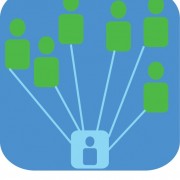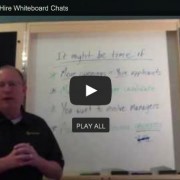Job Descriptions that Attract Diverse Job Candidates
Attracting diverse job candidates is essential to finding high quality talent for your positions. That’s because trying to find the right person to fill a vacant position is challenging, especially in our current job market.
In the past, companies mostly competed against similar industries for talent; however, that has distinctly changed. Today, workers are expanding their interests and education along with examining how to transition into different fields. The competition for essential talent has never been more fierce. Companies must compete with competitors in and outside their industry.
So when an organization has a job to fill, it is crucial to examine the content advertised to ensure that all qualified individuals feel welcome to apply. Making your company an inclusive organization–ready to recognize and appreciate diverse skill sets–should be a huge priority.
Companies with a diverse workforce are 35% more likely to experience greater financial returns than their respective non-diverse counterparts. –Forbes
Why is Attracting Diverse Job Candidates Important?
According to an article published by Forbes, diverse teams are better decision makers 87% of the time as compared to non-diverse teams. Approximately 35% of applicants will not apply to a job if the listing and/or the company do not seem to support diversity. Companies with a diverse workforce are 35% more likely to experience greater financial returns than their respective non-diverse counterparts. Diversity and inclusion help expand the knowledge, insight and social connectivity of an organization so it is a priority that needs consistent support. But how can companies ensure that they are attracting talent from all backgrounds?
Unbiased Job Description Content
Often it’s department managers who create job descriptions for their areas. They know the intricacies of the functions they oversee, so this makes sense. But this might also lead them to create or revise job descriptions with the only the current employee(s) in mind.
And while that’s a good starting point for identifying tasks and responsibilities, that exact employee will not be in that role permanently. So it’s imperative to avoid biased job description content because the next person to fill that role will likely have distinctly different, individualized attributes.
How can my Job Postings be More Inclusive?
In the “relay” to fill job vacancies, Human Resources can take the baton from other internal departments and thoroughly examine job descriptions. This provides a clear and bias-free interpretation and, if necessary, revisions of the content. Doing this helps ensure that job descriptions reach diverse populations and offer a sense of inclusivity to all applicants.
To help with consistency of verbiage, Human Resources can create an inclusive style guide available to all departments. This ensures that consistent language is used when communicating job description content with external and internal audiences.
Here are some key items to evaluate when reviewing job descriptions:
- Avoid Gender Coding which is assigning traits, characteristics or behaviors to a particular gender. Curious as to how the organization’s job description’s content passes or fails in gender coding? Check out Gender Decoder to scan content, and learn about the purpose of the tool here along with a list of feminine and masculine perceived words.
- Check pronouns. Are the pronouns “He” or “She” used in the job description? Not all individuals identify with “He” or “She”. Using “You” in the job description will leave the reader more focused upon themself and the characteristics they personify to help give the reader a better opportunity to picture themselves fulfilling the duties of that particular role. “You will lead the success of your clients…You will assist senior management with strategic planning…etc.” To the reader, hearing what “You” can do is motivating!
- Include the organization’s EEO statement. Job seekers need to know the organization is committed to equal opportunity and supports hiring for all individuals. Personalize the company’s message to all audiences that they are truly welcome.
- To accommodate readers of all levels, keep sentences and paragraphs short. Use verbiage that the reader would not have to look up in a dictionary to define. This is a job description to attract interested, qualified applicants; it is not a dissertation.
- Approximately 10% of the population is dyslexic. Dyslexia is a learning disorder that affects written and comprehended language. Individuals with Dyslexia are also part of a protected population by the EEOC. Using fonts that help language processing such as Arial, Comic Sans Verdana, Tahoma, Century Gothic, Trebuchet, Calibri or Open Sans, are easier to read because they are are sans serif. Crowded text makes it more challenging for readers with language processing challenges so avoid the use of italics and underlining and go bold instead.
- Stop buzzing around! Using buzzwords and jargon can be confusing and overwhelming. Job seekers want the job description to be to the point and simple to follow without the need to go search the online dictionary for acronyms or jargon translation. This site, Milkround, helps scan for jargon and gives a good resource of what to revise. Keep in mind, the site is based out of the United Kingdom so there could be a bit of difference between UK and US English.
- When discussing benefits, focus on generalities. “Parenting” leave as compared to maternity or paternity leave. “Parents and Guardians” as compared to “Mothers and Fathers”. “Partners” as compared to “Spouses” or “Husbands and Wives”.
- Individuals with disabilities have skills to offer. Review the job content for items that could isolate individuals with physical or cognitive disabilities. Does the person have to actually “lift” an item to move it, or could the person move the item in an alternative way? Does a person have to read instructions, or could that person listen to an audio recording instead? One size does not fit all
Commit to a Diverse, Inclusive Culture
Creating diverse content in job descriptions is an important step toward attracting diverse job candidates. But they are only words if the organization’s culture does not embrace diversity and inclusion initiatives. Make sure that what is written in the job description regarding the warm welcome for all qualified individuals to apply is sincere.
Human Resources is a champion for diversity and inclusion. Taking time to inspect job descriptions and promoting inclusive language and actions within the organization will save time in the long run. And crafting content to reach diverse audiences will become a norm as time evolves. Diverse, inclusive job descriptions will help organizations yield an opportunity to fulfill its main goal – supply the organization with talent for company growth.
Click here to learn how ExactHire HR Software can help your team create a library of diverse job templates that can be used to help save time posting jobs, screening applicants, and attracting diverse job candidates.
Photo by Tim Mossholder on Unsplash









 15% OFF FULL-SERVICE HIRING • APPLICANT TRACKING SOFTWARE • ONBOARDING SOFTWARE
15% OFF FULL-SERVICE HIRING • APPLICANT TRACKING SOFTWARE • ONBOARDING SOFTWARE